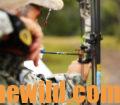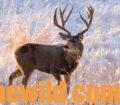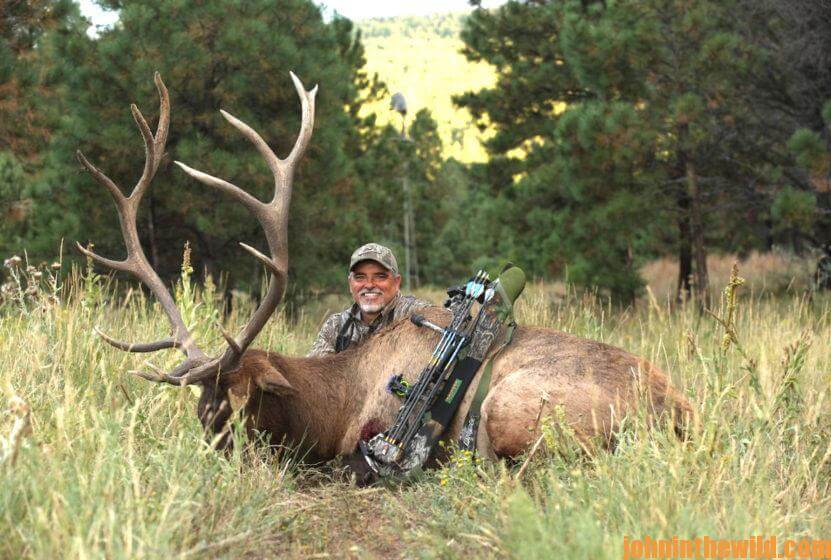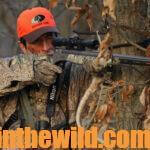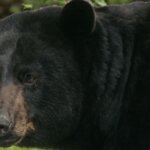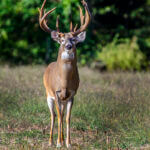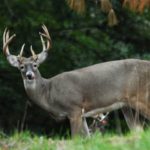Editor’s Note: Editor’s Note: According to Troy Ruiz, a cameraman and video producer for Primos Hunting (https://www.primos.com/) “We hunt three different states for elk. We hunt New Mexico almost every year, about every second year we hunt a ranch in Montana, and then we have a ranch we hunt in Colorado that’s very, very, very high at 13,200 feet of elevation.”
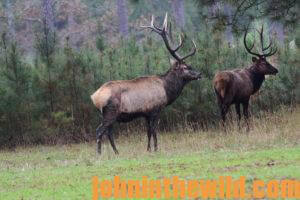 Our group from Primos Hunting took two bull elk from the McLemore Canyon one year. Several of us from Primos Hunting were on this hunt. On this first day of the hunt, we went into a canyon not really intending to hunt – just to see if any elk were there. We found a water hole, heard some elk there, slipped up to it, and saw some elk out in the water. One nice bull was swimming around and chasing cows. This bull had a weird, non-typical rack. Soon three bulls had been taken by our group, but because I was filming, I didn’t get to hunt until everybody else had taken their bulls.
Our group from Primos Hunting took two bull elk from the McLemore Canyon one year. Several of us from Primos Hunting were on this hunt. On this first day of the hunt, we went into a canyon not really intending to hunt – just to see if any elk were there. We found a water hole, heard some elk there, slipped up to it, and saw some elk out in the water. One nice bull was swimming around and chasing cows. This bull had a weird, non-typical rack. Soon three bulls had been taken by our group, but because I was filming, I didn’t get to hunt until everybody else had taken their bulls.
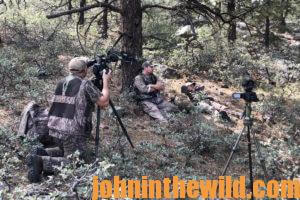 The elk were moving in a weird pattern on this hunt, and we found out that flies and water were the two things causing the elk to do that. The elk were going up in the timber early in the morning, and about mid-afternoon they would come down to a meadow and bed-down in the prairie. That timber held tons of black flies. We finally decided that the elk were coming out of the timber in mid-afternoon and bedding-down there because the wind was strong enough to blow the flies away from them. For three days, we watched the elk follow this same pattern. So, we decided to go to a drainage where we thought the elk would come out of the timber and walk out into the prairie. We heard a herd of elk coming. I got ahead of the herd, and a bull came out 15 yards in from of me. However, I couldn’t get a shot at him.
The elk were moving in a weird pattern on this hunt, and we found out that flies and water were the two things causing the elk to do that. The elk were going up in the timber early in the morning, and about mid-afternoon they would come down to a meadow and bed-down in the prairie. That timber held tons of black flies. We finally decided that the elk were coming out of the timber in mid-afternoon and bedding-down there because the wind was strong enough to blow the flies away from them. For three days, we watched the elk follow this same pattern. So, we decided to go to a drainage where we thought the elk would come out of the timber and walk out into the prairie. We heard a herd of elk coming. I got ahead of the herd, and a bull came out 15 yards in from of me. However, I couldn’t get a shot at him.
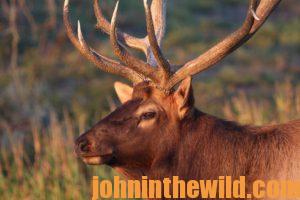 Then the bull and I both heard another bull bugle off to the west. But instead of stepping-out into the prairie where I could get a clean shot, the bull turned and went to the west to try to intercept this other bull that just had bugled. The other bull had a wider rack and longer main beams. I decided to get to the trail the other bull was coming down before the bull I wanted to take got to the trail. I grabbed my bow and one arrow and took off running as fast as I could. A little pocket in the wood line allowed me to stay low enough so the cows feeding out in the prairie wouldn’t see me. Once I got to the pocket and close to the trail where the cows were coming out, the cows that just had come down the trail in front of the second bull spotted me but kept on walking out into the grasslands. I heard the big bull bugle. When I finally reached the last tree that I could hide behind, the cows were coming out in front of me at 15 yards. I was at full draw. The bull spotted me and took off running. When he got out on the prairie, I estimated he was at 43 yards.
Then the bull and I both heard another bull bugle off to the west. But instead of stepping-out into the prairie where I could get a clean shot, the bull turned and went to the west to try to intercept this other bull that just had bugled. The other bull had a wider rack and longer main beams. I decided to get to the trail the other bull was coming down before the bull I wanted to take got to the trail. I grabbed my bow and one arrow and took off running as fast as I could. A little pocket in the wood line allowed me to stay low enough so the cows feeding out in the prairie wouldn’t see me. Once I got to the pocket and close to the trail where the cows were coming out, the cows that just had come down the trail in front of the second bull spotted me but kept on walking out into the grasslands. I heard the big bull bugle. When I finally reached the last tree that I could hide behind, the cows were coming out in front of me at 15 yards. I was at full draw. The bull spotted me and took off running. When he got out on the prairie, I estimated he was at 43 yards.
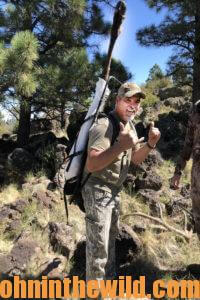 I cow called and stopped the bull. I put my 50-yard pin on the bull’s heart and my 40-yard pin right at the midpoint of where the bull’s lungs should be and released the arrow. And, once the bull took the arrow, he ran and went over a ridge. I didn’t see the bull when he went down, but the videographer videoed the elk running over the hill and then going down not 50 yards from me. I went and put my hands on the bull’s antlers, returned to camp to get the Polaris Ranger and drove right up to him. We used a method we’d developed. We would sit the elk up like he was sitting on his hindquarters and got him close to the Ranger. Then when he fell backwards, he fell right into the Ranger. Once you got the elk past his middle in the Ranger, then two people could pick his hindquarters up and get them into the Ranger too. So, we had an easy task getting that elk back to camp and butchered.
I cow called and stopped the bull. I put my 50-yard pin on the bull’s heart and my 40-yard pin right at the midpoint of where the bull’s lungs should be and released the arrow. And, once the bull took the arrow, he ran and went over a ridge. I didn’t see the bull when he went down, but the videographer videoed the elk running over the hill and then going down not 50 yards from me. I went and put my hands on the bull’s antlers, returned to camp to get the Polaris Ranger and drove right up to him. We used a method we’d developed. We would sit the elk up like he was sitting on his hindquarters and got him close to the Ranger. Then when he fell backwards, he fell right into the Ranger. Once you got the elk past his middle in the Ranger, then two people could pick his hindquarters up and get them into the Ranger too. So, we had an easy task getting that elk back to camp and butchered.
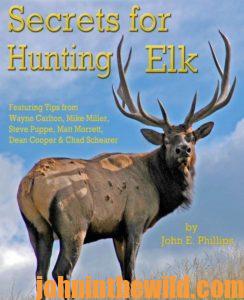 To learn more about hunting elk successfully, check out John E. Phillips’ book, “Secrets for Hunting Elk,” available in Kindle and Audible at https://www.amazon.com/. You may have to copy and paste this click into your browser. (When you click on this book, notice on the left where Amazon allows you to read 10% of the book for free). On the right side of the page and below the offer for a free Audible trial, you can click on Buy the Audible with one click.
To learn more about hunting elk successfully, check out John E. Phillips’ book, “Secrets for Hunting Elk,” available in Kindle and Audible at https://www.amazon.com/. You may have to copy and paste this click into your browser. (When you click on this book, notice on the left where Amazon allows you to read 10% of the book for free). On the right side of the page and below the offer for a free Audible trial, you can click on Buy the Audible with one click.
Tomorrow: How to Take Big Mule Deer

